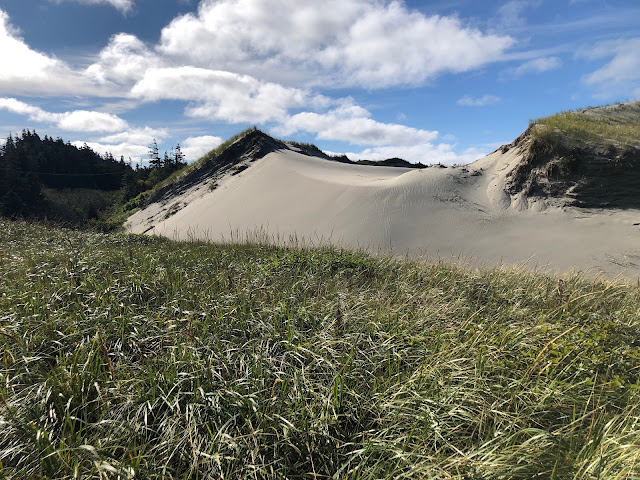More Wonders! Shallow Bay Part 1
I haven't blogged in a few days because Wednesday was not a bloggable day. I made connections with people and visited some galleries in Corner Brook.
Yesterday, on the other hand, was filled with adventures all day long and there is enough material from that day to fill several blog entries. So here goes!
I went on another hike with Michael and Anne. This time to Shallow Bay, which is not far from the northern park boundary. It has the longest beach in the park. This is a place of dynamic edges! We started off by the dunes.
These dunes grow and change. The grasses you see in the foreground provide structure for the dunes with their root systems. This is why dune habitats are protected in many areas. Too much foot or bike traffic over these dunes ruins their stability. |
| The roots of the dune grasses are visible in the centre of this photo. |
Once on the beach, the entire landscape changed! We were there at low tide so we were able to walk out quite far. Michael waded into the water and found a young lobster. He brought it over for us to see and then returned it to the exact spot where he found it. This lobster had only one claw, which indicates that it had been in at least one bad fight. If all goes well for this little guy, it should be able to grow back the missing claw.
The entire shoreline is very scenic.
It took us a long time to walk to the place where we ate our picnic lunch. This is because all three of us walk with our heads down, noticing the many wonders beneath our feet.
For example, Michael pointed out some coarse, green sand. He explained that this was not sand at all, but crushed shells of small mollusks and that the green was actually sea urchin spines! In order for there to be the amount of green sand we saw, we must conclude that there are LOTS of sea urchins in the water! And clearly there are LOTS of other organisms in the water, too!
 |
| You can see the yellow-green patches on this section of beach. |
My favourite one was a tiny little ecosystem consisting of a small rock with a periwinkle on it, branching coralline algae, and knotwrack. On the knotwrack, I can see little calcareous tube worms and bryozoans!
 |
| In places, the beach was just covered in dried seaweed and other organisms. This crunches underfoot. |













Do you take notes on these walks? There is so much information to take in. Grandmo is right there with you.
ReplyDeleteI take a few notes. There is so much to learn, though, that I can't possibly get it all. :) I think she is.
DeleteFascinated by this "wrack line" concept. So rich!
ReplyDeleteYes, it really is!
DeleteOh, to have these quit walks are so inspiring. I don’t have enough of them. Enjoy Mary.
ReplyDeleteI am definitely enjoying them! And am grateful for those who take me along with them!
DeleteImpressive
ReplyDelete